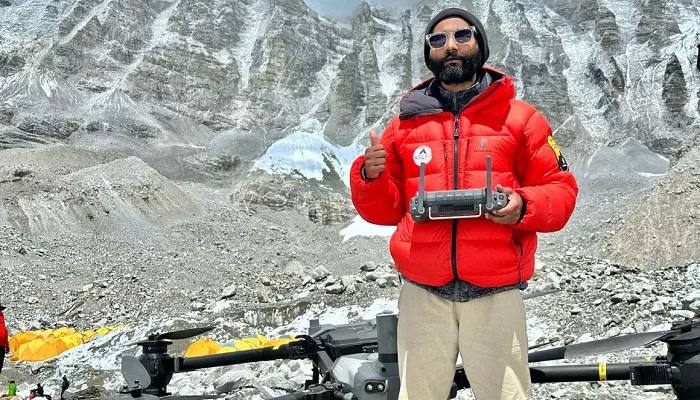At the top of the world, where glaciers glisten and rocky peaks rise into the sky, silence often dominates. But now, that quiet is being broken—by the sound of drones.
Milan Pandey, a drone pilot from Airlift Technology, sits at Everest Base Camp, watching his drone soar toward the mountain. He’s helping make Mount Everest safer for climbers and Sherpas, without ever needing to strap on crampons or carry an ice axe.
Pandey’s drones are being used to carry ladders, ropes, oxygen cylinders, and other equipment to the treacherous Khumbu Icefall, located between Base Camp and Camp One. This route, one of the most dangerous on Everest, has claimed the lives of dozens of Sherpas over the decades.
The idea is simple but powerful: reduce the number of trips Sherpas must make up and down the icefall. That means less risk—and potentially, fewer lives lost.
Sherpas have long been the backbone of Everest expeditions, using their unmatched mountain knowledge to guide climbers. Now, thanks to technology from local drone-mapping startup Airlift Technology, their work is becoming safer and more efficient.
The numbers highlight the change. Base Camp sits at 5,364 meters (17,598 feet), and Camp One is at 6,065 meters (19,900 feet). The aerial distance between them is about 1.8 miles. For a Sherpa, this journey takes six to seven hours. For a drone, it takes just six to seven minutes.
Mingma G Sherpa, from the expedition company Imagine Nepal, saw the potential of drones after losing three close friends in a 2023 avalanche. Their bodies were never recovered.
“They had to go up and down so many times to find the route and bring up gear,” he said. “I had heard drones were used in China for this. I thought—why not here?”
At the same time, Airlift Nepal CEO Raj Bikram had been working with local officials on using drones to map Everest in 3D. When the region’s mayor asked how much weight the drones could carry, it opened the door to something bigger.
In April 2024, with help from two drones donated by Chinese drone-maker DJI, testing began. The team wasn’t sure at first how the drones would perform in extreme cold and high altitudes. Wind and poor visibility posed major challenges, and it took about a month to learn the terrain.
Their first major mission involved removing about 1,100 pounds of trash from Camp One to Base Camp. Each drone can carry up to 66 pounds, but they limit loads to around 44 pounds per flight to ensure safety. It took more than 40 flights to finish the job.
Pandey says that during the 2025 Everest climbing season, drones will deliver gear to Sherpas before the season begins and will later be used for trash removal. The process works like this: Sherpas scout the path and radio back GPS coordinates for where gear is needed. Pandey then sends drones with ladders, ropes, oxygen, or even medical supplies.
At the moment, Airlift has two drones. Only one is being used this year, while the other remains on standby. But the team is prepared to expand if needed.
One major hurdle is cost. Each drone is priced at $70,000—and that’s just the start. Since there’s no electricity at Base Camp, they rely on fuel to charge batteries. Add in food, lodging, and staff wages, and the expenses rise quickly.
Bikram, who built his first drone in Nepal more than ten years ago, says he’s passionate about this work. His drones were also used during rescue efforts following the 2015 Nepal earthquake.
Pandey says safety is a top priority. “It’s not just about moving gear. If someone gets lost, we can help locate them. That’s a big part of what we do.”
Many younger Sherpas are choosing to leave mountain work behind and pursue safer, better-paying jobs abroad. But Pandey hopes drones can make the profession safer and bring some of them back. “The Sherpa tradition is vital to Everest. Without them, climbing would not be possible,” he said.
One of those who remains is 28-year-old Dawa Janzu Sherpa. He has worked with the icefall doctors—Sherpas who specialize in setting routes—for eight years. While older Sherpas plan the route, it’s younger men like Janzu who lead the way, climbing first through dangerous ice.
“This season, there’s been a lot of dry ice and unstable ice towers,” he said. “Using drones helps us find a route and reduces the need to climb up and down for gear.” In past years, delays in setting trails could stall entire expeditions. This year, drones have helped speed things up despite bad weather.
Janzu supports his wife and two daughters. He knows the risks of his job but welcomes anything that makes it safer. “This job is dangerous. If drones can help, that’s a good thing.”
Climbers are now arriving at Base Camp for the short 2025 season. Most will attempt their summit bids in April and May.
Caroline Ogle, with New Zealand-based Adventure Consultants, has spent five seasons at Base Camp. She believes drones are simply the latest in a long line of technologies that have made climbing safer.
“First it was radios, then satellite phones, weather forecasts. Now it’s drones. It’s all part of the evolution,” she said.
Lisa Thompson, who has climbed the highest peaks on all seven continents and now trains climbers through Alpine Athletics, agrees.
“The mountain is still the mountain,” she said. “The challenge is still there. But using technology to make it safer? That’s smart—and necessary.”


